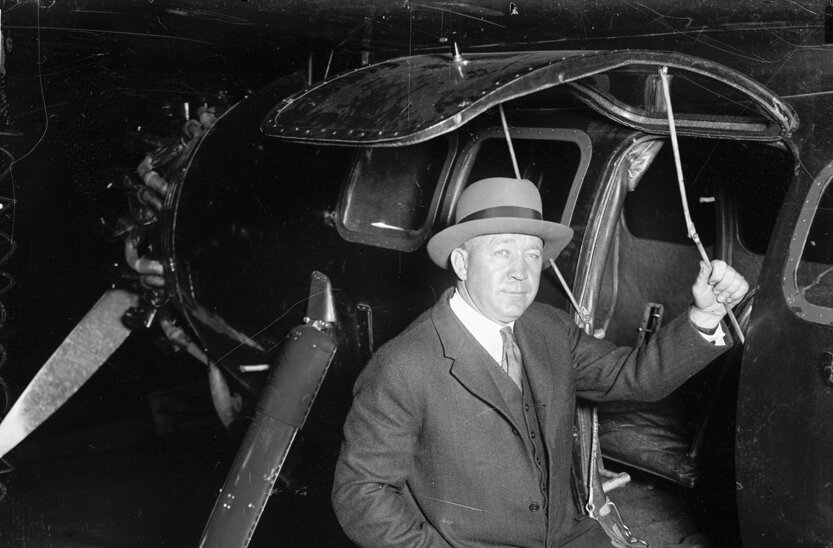Knute Rockne (1888-1931), standing by a small airplane in a hangar in Chicago, Illinois. (Photo: Courtesy of Rockne of Ages)
Editor’s note: To commemorate the 91st anniversary of the tragic death of Knute Rockne on March 31, 1931. Jeffrey G. Harrell, author of Rockne of Ages and As God’s Witness: the Death of Knute Rockne wrote this piece for Fighting Irish Preview.
What the game of football lost in that plane crash on March 31, 1931 was immeasurable.
The forward pass was left to perfect itself. The route tree forced to branch out on its own. A streamlined ball with an innovative air valve to regulate air pressure was bequeathed to disciples who chalked blackboards with box offenses, pre-snap shifts, brush blocks and platooning defenses, yet mourned the loss of rabble-rousing words that could incite the troops to run through a brick wall with a game on the line.
Knute Kenneth Rockne was only 43 years old when he died. His brief life was so impactful and so far ahead of his breathtaking time, his iconic presence in that wooden Fokker F-10 plane that went down in the Kansas plains 91 years ago caused the aviation industry to reassess safety standards and convert the manufacturing of aircraft from wood to metal.
Modern football lost its great-grandfather. Sports lost its coast-to-coast pioneer. America lost its greatest sports visionary. Notre Dame lost its voice.
Then a wistful thing happened on the way to life ever-after: Knute Rockne was forgotten.
Outside of the statue at the North Gate of Notre Dame Stadium – the House That Rockne Built – Rockne’s spirit perished from the memory banks of the University of Notre Dame, the small Catholic school in South Bend that the legendary ball coach singlehandedly carved into a global sports brand on par with only the New York Yankees.
Ask any baseball fan today about Rockne’s only true lifetime peer, Babe Ruth, and they’ll rattle off every homerun the Bambino smashed along with the number of hot dogs he gulped down before a game.
But bring up Knute Rockne to any football player, student, coach, professor, faculty member, administrator, priest, anybody around Notre Dame today, I have., and the blank stare and weak grin that greets the subject of Rockne is mind-boggling, if not sorrowfully troubling. One recently-graduated player who now plays in the NFL said that in his four-year Notre Dame career, he “never” heard Rockne’s name invoked by “anybody… I really don’t know anything about him,” the player admitted.
No forgotten spirit warrants education among the 21st Century millennial as much as the greatest visionary in the history of American sports. It’s why I resurrected Rockne’s voice to tell his own life in his own words in my book, “Rockne of Ages,” although a posthumous biography of the coach who literally shaped the football and engineered its first air valve has drawn little more than a passing, “I didn’t know that.”
No lost American tragedy hungers more for historical truth than the cause of the plane crash that has been swept under a rug of time for nearly a full century. It took a bomb ordered by Al Capone that blew up the plane carrying Knute Rockne, five other passengers, a pilot and co-pilot to resurrect the spirit of the iconic coach who deserves his own exclusive football Mount Rushmore.
That’s right… a bomb… on Al Capone’s order… killed Knute Rockne.
Unbelievable… not necessarily the bomb by Al Capone, but the notion that it took an Al Capone bombshell for today’s football crowd to remember that Knute Rockne existed.
“What do you think happened?” is the question that has been asked frequently over the past year during my book signings to promote “Rockne of Ages” and “As God’s Witness: The Death of Knute Rockne.”
After combing hundreds of newspaper accounts from the time period, books, magazines, and the Holy Grail that served as the voice of the book’s fascinating storyline – a tape recording of the last interview Notre Dame priest Father John Reynolds gave before his death in 1986 – what do I think happened?
One day after Father Reynolds testified against a hit man for Capone, he gave his plane ticket to his friend Knute Rockne. Rockne had to be in Los Angeles the following week to sign a film contract. Father Reynolds was obligated to stay close to Chicago because the trial of Leo Brothers, the Capone hit man accused of murdering Chicago Tribune reporter Jake Lingle, was still in session.
Three days later, on March 31, 1931, the plane exploded in mid-air.
“A terrific explosion in the foggy sky…” according to teen-ager Edward Baker’s eyewitness account reported in that day’s evening edition of the Sedalia Democrat in Sedalia, Missouri, and every other newspaper across the country that carried a same-day report of the crash.
Two years later, on Jan. 7, 1933, newspapers across the country screamed the headline, “BOMB KILLED ROCKNE, PUT IN PLANE BY GANG,” over a story sourced by federal “Secret Service operatives” that a bomb was set by Capone in retaliation for Father Reynolds testimony in the Brothers’ trial.
The bomb story died in the newspapers that day. The official cause of the crash was deemed by the investigative Aeronautics Branch of the U.S. Department of Commerce as “inconclusive.”
Now, a century later, extraordinary circumstances that led up to the crash give the bomb theory strong justification.
Capone’s men spent months leading up to the trial trying to intimidate Father Reynolds into not taking the stand. Two anonymous notes Father Reynolds received days before the trial contained the same ominous message: “Notre Dame will be more sorry than it realizes if they allow you to testify.”
“Notre Dame will be more sorry…” Not Father Reynolds. Not Knute Rockne. “Notre Dame…”
While I believe Father Reynolds was the initial target of the bomb (a priest dying in a plane crash kept Capone out of the crosshairs of any suspicions), Rockne’s presence on the plane served up a magnanimous payback to the school with no attention drawn toward Capone whatsoever. As it turned out, the plane crash stood as nothing more than a tragic accident for nearly a century.
However, the events that occurred up to the plane’s delayed takeoff offer evidence of a conspiracy that involved a string of nefarious actions described in the book.
The following is an excerpt:
“Six passengers were manifested, only half filling the 12-place cabin…” retired U.S. Air Force Lt. Colonel Boardman C. Reed wrote in the January 1989 issue of “Vintage Airplane” magazine, “but one had a change of plans at the last minute. Knute Rockne took his place.”
Rockne was traveling on the overnight train to Kansas City when the Transcontinental Western Air Express Fokker F-10AF-1 NC 999E flew into Kansas City from Los Angeles. The plane was scheduled to be turned back to retrace its route to Los Angeles as “Flight 5” the next morning, March 31.
TWA mechanic E.C. “Red” Long thought better of putting the plane in the air on his signature. Long had inspected the plane a few days before and found “… the wing panels were all loose on the wing. They were coming loose and it would take days to fix it, and I said the airplane wasn’t fit to fly.”
Long refused to sign the log. But an unknown TWA supervisor pulled rank on the mechanic by claiming the company needed the plane in service.
“I don’t know who signed the plane off, but they took the airplane,” Long told DOC investigators. “Nobody was safe in that aircraft.”
That morning, TWA Flight 5 was supposed to depart Kansas City Municipal Airport at 8:30 a.m. The plane remained on the ground for 45 minutes to wait for a late shipment of mail. According to the investigation report, “… the airline removed four seats from the rear of the plane and replaced it by a mail bin.” The late-addition mail bin was filled with 28 pouches that weighed 95 pounds.
“Would that have any effect in balancing?” one investigator asked in the DOC official crash investigation report. “If Govt. or private inquiry shows that the airline was negligent, what penalty can the govt. inflict on the airline?”
TWA employees would not have protested if Flight 5 had stayed grounded under mechanic Red Long’s order. In the wake of drastic salary cuts outlined in the DOC investigation, pilots and mechanics were ready to walk off the job with morale among all employees “shot” after the company cut the pay of pilots “about 30%” with “no warning or notice,” lead investigator Leonard Jurden wrote in a letter to Gilbert Budwig.
“Due to this condition and then the accident, morale sagged even lower and nerves ragged,” Jurden noted.
Red flags all over Kansas City Municipal Airport that March 31, 1931 morning begged the question: Why was Fokker F-10A Flight 5 allowed to take off?
The TWA flight mechanic had refused to sign off on the plane’s structural safety. A last-minute ticket transfer had put Knute Rockne aboard as a passenger… meaning, the TWA supervisor who overruled Red Long at the last minute knew that one of the most beloved sports figures in the country was potentially in danger of traveling on a plane that had already been determined by the military and TWA to be structurally unsafe.
Then, takeoff was delayed for 45 minutes to await the arrival of a late mail shipment. Four passenger seats were removed to make space for a bin filled with 95 pounds of mail.
Weather conditions were cold, cloudy and iffy. And TWA employees were ready to walk off the job over sudden salary cuts.
Somebody wanted that plane carrying Knute Rockne in the air.
“Why hasn’t this story come out before?” is another question I get frequently. It’s a question better left for answers from the countless Rockne biographers over the years who settled for the proverbial “Knute Rockne was born in Voss, Norway…” biography. It was their same old Gipper story that left everybody, particularly the Notre Dame community, bored as stiff as the memory of Rockne’s ghost became.
Relegated to an ignored bronze relic, Rockne himself probably rolled over in his grave.
The monumental tragedy is that America lost Knute Rockne to the historical reality of a gangster’s bomb that robbed the country of its greatest natural sports resource at the premature age of 43. We’ll never know what else Rockne would have put his brilliant vision to had he lived another 10, 20, 30 years or more. Hopefully, the newfound truth has set Rockne’s modern-day spirit free for a new generation to behold.
Ninety-one years later, life still goes on. Notre Dame Stadium and every football field from sea to shining sea is engulfed by the spirit of Knute Kenneth Rockne.
Time hasn’t robbed us from celebrating the spirit of Rockne every time a forward pass is thrown for a touchdown.
Whenever a sports team travels from New York to Los Angeles, from Puerto Rico to Hawaii, from Ireland to China, to every ballpark, stadium and coliseum in the country and around the world, Rockne is still flying with them.
Every time a player grips a football, that’s still the shape of Rockne in hand.
When we walk on the campus of the University of Notre Dame, we’re still walking in Rockne’s footsteps.
When we breathe the air in and around Notre Dame Stadium, we’re still breathing Rockne air.
On this 91st anniversary of his death, as long as there’s football to be played, the spirit of Knute Rockne is alive, well, immortal, and…
… unforgettable.
Jeffrey G. Harrell is the author of “Rockne of Ages” and “As God’s Witness: The Death of Knute Rockne.” Both titles are available on Amazon, Barnes & Noble, and at Hammes Notre Dame Bookstore. For more visit spiritofknute.com.

